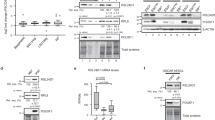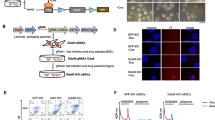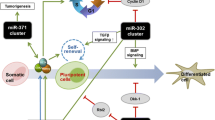Abstract
As the first and rate-limiting step in ribosome biogenesis, rDNA transcription undergoes significant dynamic changes during cell pluripotency alteration. Over the past decades, rDNA activity has demonstrated dynamic changes, but most people view it as passive compliance with cellular needs. The evidence for rDNA transcriptional activity determining stem cell pluripotency is growing as research advances, resulting in the arrest of embryonic development and impairment of stem cell lines stemness by rDNA transcription inhibition. The exact mechanism by which rDNA activation influences pluripotency remains unknown. The first objective of this opinion article is to describe rDNA changes in the pathological and physiological course of life, including developmental diseases, tumor genesis, and stem cell differentiation. After that, we propose three hypotheses regarding rDNA regulation of pluripotency: 1) Specialized ribosomes synthesized from rDNA variant, 2) Nucleolar stress induced by the drop of rDNA transcription, 3) Interchromosomal interactions between rDNA and other genes. The pluripotency regulatory center is expected to focus strongly on rDNA. A small molecule inhibitor of rDNA is used to treat tumors caused by abnormal pluripotency activation. By understanding how rDNA regulates pluripotency, we hope to treat developmental diseases and safely apply somatic cell reprogramming in clinical settings.
Graphical Abstract





Similar content being viewed by others
Data Availability
Not applicable.
Abbreviations
- 5’UTR :
-
5’Untranslated regions
- Act D :
-
Actinomycin D
- ATRA :
-
All-trans-retinoic acid
- AD :
-
Alzheimer's disease
- ALS :
-
Amyotrophic lateral sclerosis
- ASD :
-
Autism spectrum disorder
- CIN :
-
Cervical intraepithelial neoplasia
- 3C :
-
Chromosome Conformation Capture
- 4C :
-
Chromosome conformation capture on chip
- DFC :
-
Dense fibrillar center
- EGA :
-
Embryonic gene activation
- ESC :
-
Embryonic stem cells
- EGF :
-
Epidermal growth factor
- FC :
-
Fibrillar center
- FMRP :
-
Fragile-X mental retardation protein
- FTD :
-
Frontotemporal dementia
- GO :
-
Gene Ontology
- GSC :
-
Germline stem cells
- GC :
-
Granular component
- HSC :
-
Hematopoietic stem cells
- HGSOC :
-
High grade serous ovarian cancer
- Hi-C :
-
High-throughput chromatin conformation capture technology
- HDACi :
-
Histone deacetylase inhibitor
- HCC :
-
Human hepatocellular carcinoma
- h-iPSCs :
-
Human induce pluripotent stem cells
- HD :
-
Huntington's disease
- iPSCs :
-
Induced pluripotent stem cells
- IR :
-
Ionizing irradiation
- mTOR :
-
Mammalian target of rapamycin
- MET :
-
Mesenchymal-to-epithelial transition
- NBS1 :
-
Nijmegen breakage syndrome protein 1
- NORs :
-
Nucleolar organizer regions
- OSCC :
-
Oral squamous cell carcinoma
- PD :
-
Parkinson's disease
- PMA :
-
Phorbol 12-myristate 13-acetate
- PRC2 :
-
Polycomb repressive complex 2
- pre-rRNA :
-
Precursor rRNA
- SL-1 :
-
Promoter-selectivity factor
- RHS7 :
-
rad50 hypersensitive site 7
- RPS :
-
Ribosomal proteins
- Ribo-seq :
-
Ribosome profiling sequencing
- pol I :
-
RNA polymerase I complex
- SCNT :
-
Somatic cell nuclear transfer
- SIM :
-
Structural illumination superresolution microscopy
- T-ALL :
-
T-cell acute lymphoblastic leukemia
- TCS :
-
Treacher Collins Syndrome
- TGC :
-
Trophoblast giant cells
- TIP5 :
-
TTF-I-interacting protein 5
- Tau :
-
Tubulin associated units
- WGS :
-
Whole-genome sequencing
- ZGA :
-
Zygotic genome activation
References
Friedrich, J. K., et al. (2005). TBP-TAF complex SL1 directs RNA polymerase I pre-initiation complex formation and stabilizes upstream binding factor at the rDNA promoter. Journal of Biological Chemistry, 280(33), 29551–29558.
Miyazawa, N., et al. (2014). Human cell growth regulator Ly-1 antibody reactive homologue accelerates processing of preribosomal RNA. Genes to Cells, 19(4), 273–286.
Kim, D. S., et al. (2019). Activation of PARP-1 by snoRNAs controls ribosome biogenesis and cell growth via the RNA helicase DDX21. Molecular Cell, 75(6), 1270-1285.e14.
Han, X., et al. (2020). Construction of a human cell landscape at single-cell level. Nature, 581(7808), 303–309.
Parks, M. M., et al. (2018). Variant ribosomal RNA alleles are conserved and exhibit tissue-specific expression. Science Advances, 4(2), eaao0665.
Yu, J., Oentaryo, M. J., & Lee, C.W. (2021). Local protein synthesis of neuronal MT1-MMP for agrin-induced presynaptic development. Development, 148(10), dev199000.
Federico, C., et al. (2018). Phosphorylated nucleolar Tau protein is related to the neuronal in vitro differentiation. Gene, 664, 1–11.
Le Goff, S., et al. (2021). p53 activation during ribosome biogenesis regulates normal erythroid differentiation. Blood, 137(1), 89–102.
Norris, K., Hopes, T., & Aspden, J. L. (2021). Ribosome heterogeneity and specialization in development. Wiley Interdiscip Rev RNA, 12(4), e1644.
Dannheisig, D. P., et al. (2021). Nucleolar stress functions upstream to stimulate expression of autophagy regulators. Cancers (Basel), 13(24), 6220.
de Pedro, I., et al. (2018). Sublethal UV irradiation induces squamous differentiation via a p53-independent, DNA damage-mitosis checkpoint. Cell Death & Disease, 9(11), 1094.
Wang, L., et al. (2016). Effect of Hypoxia-regulated Polo-like Kinase 3 (Plk3) on human limbal stem cell differentiation. Journal of Biological Chemistry, 291(32), 16519–16529.
Tchurikov, N. A., & Kravatsky, Y. V. (2021). The role of rDNA clusters in global epigenetic gene regulation. Frontiers in Genetics, 12, 730633.
Hannan, A. J. (2018). Tandem repeats mediating genetic plasticity in health and disease. Nature Reviews Genetics, 19(5), 286–298.
Calo, E., et al. (2018). Tissue-selective effects of nucleolar stress and rDNA damage in developmental disorders. Nature, 554(7690), 112–117.
Tchurikov, N. A., et al. (2019). rDNA clusters make contact with genes that are involved in differentiation and cancer and change contacts after heat shock treatment. Cells, 8(11), 1393.
Jesse, S., et al. (2017). Ribosomal transcription is regulated by PGC-1alpha and disturbed in Huntington’s disease. Science and Reports, 7(1), 8513.
Lee, J., et al. (2014). Nucleolar dysfunction in Huntington’s disease. Biochimica et Biophysica Acta, 1842(6), 785–790.
Zhao, Q., et al. (2016). Serum starvation-induced cell cycle synchronization stimulated mouse rDNA transcription reactivation during somatic cell reprogramming into iPSCs. Stem Cell Research & Therapy, 7(1), 112.
Valdez, B. C., et al. (2004). The Treacher Collins syndrome (TCOF1) gene product is involved in ribosomal DNA gene transcription by interacting with upstream binding factor. Proceedings of the National Academy of Sciences of the United States of America, 101(29), 10709–10714.
Zhang, J., Zhang, J. X., & Zhang, Q. L. (2016). PI3K/AKT/mTOR-mediated autophagy in the development of autism spectrum disorder. Brain Research Bulletin, 125, 152–158.
Nakagawa, T., et al. (2020). The autism-related protein SETD5 controls neural cell proliferation through epigenetic regulation of rDNA expression. iScience, 23(4), 101030.
Evsyukov, V., et al. (2017). Genetic mutations linked to Parkinson’s disease differentially control nucleolar activity in pre-symptomatic mouse models. Disease Models & Mechanisms, 10(5), 633–643.
Regier, M., et al. (2019). Evidence for decreased nucleolar PARP-1 as an early marker of cognitive impairment. Neural Plasticity, 2019, 4383258.
Pietrzak, M., et al. (2011). Epigenetic silencing of nucleolar rRNA genes in Alzheimer’s disease. PLoS ONE, 6(7), e22585.
Larsen, D. H., et al. (2014). The NBS1-Treacle complex controls ribosomal RNA transcription in response to DNA damage. Nature Cell Biology, 16(8), 792–803.
Kadakia, S., et al. (2014). Treacher Collins Syndrome: The genetics of a craniofacial disease. International Journal of Pediatric Otorhinolaryngology, 78(6), 893–898.
Gkogkas, C. G., et al. (2013). Autism-related deficits via dysregulated eIF4E-dependent translational control. Nature, 493(7432), 371–377.
Ascano, M. J., et al. (2012). FMRP targets distinct mRNA sequence elements to regulate protein expression. Nature, 492(7429), 382–386.
Sakai, Y., et al. (2019). Hyperactivation of mTORC1 disrupts cellular homeostasis in cerebellar Purkinje cells. Science and Reports, 9(1), 2799.
Marogianni, C., et al. (2020). Neurodegeneration and inflammation-an interesting interplay in Parkinson’s disease. International Journal of Molecular Sciences, 21(22), 8421.
Sonmez, A., et al. (2021). Nucleolar stress controls mutant Huntington toxicity and monitors Huntington’s disease progression. Cell Death & Disease, 12(12), 1139.
Maina, M. B., et al. (2018). The involvement of tau in nucleolar transcription and the stress response. Acta Neuropathologica Communications, 6(1), 70.
Allen, K. D., et al. (2018). Learning-induced ribosomal RNA is required for memory consolidation in mice-Evidence of differentially expressed rRNA variants in learning and memory. PLoS ONE, 13(10), e0203374.
Smirnov, E., Chmurciakova, N., & Cmarko, D. (2021). Human rDNA and cancer. Cells, 10(12), 3452.
Feng, L., et al. (2020). Ribosomal DNA copy number is associated with P53 status and levels of heavy metals in gastrectomy specimens from gastric cancer patients. Environment International, 138, 105593.
Kim, H. G., et al. (2021). Reduced rDNA transcription diminishes skeletal muscle ribosomal capacity and protein synthesis in cancer cachexia. The FASEB Journal, 35(2), e21335.
Zhou, H., et al. (2016). Overexpression of ribosomal RNA in the development of human cervical cancer is associated with rDNA promoter hypomethylation. PLoS ONE, 11(10), e0163340.
Barna, M., et al. (2008). Suppression of Myc oncogenic activity by ribosomal protein haploinsufficiency. Nature, 456(7224), 971–975.
Ha, S., et al. (2019). Reduced ribosomal RNA expression and unchanged ribosomal DNA promoter methylation in oral squamous cell carcinoma. Molecular Genetics & Genomic Medicine, 7(7), e00783.
Sanij, E., et al. (2020). CX-5461 activates the DNA damage response and demonstrates therapeutic efficacy in high-grade serous ovarian cancer. Nature Communications, 11(1), 2641.
Okamoto, S., et al. (2020). The rRNA synthesis inhibitor CX-5461 may induce autophagy that inhibits anticancer drug-induced cell damage to leukemia cells. Bioscience, Biotechnology, and Biochemistry, 84(11), 2319–2326.
Wu, T. D., et al. (2020). Peripheral T cell expansion predicts tumour infiltration and clinical response. Nature, 579(7798), 274–278.
Yu, H., et al. (2021). rRNA biogenesis regulates mouse 2C-like state by 3D structure reorganization of peri-nucleolar heterochromatin. Nature Communications, 12(1), 6365.
Izumikawa, K., et al. (2019). LYAR potentiates rRNA synthesis by recruiting BRD2/4 and the MYST-type acetyltransferase KAT7 to rDNA. Nucleic Acids Research, 47(19), 10357–10372.
Zhang, H., et al. (2020). DEAD-box helicase 18 counteracts PRC2 to safeguard ribosomal DNA in pluripotency regulation. Cell Reports, 30(1), 81-97.e7.
Percharde, M., et al. (2018). A LINE1-nucleolin partnership regulates early development and ESC identity. Cell, 174(2), 391-405.e19.
Li, H., et al. (2009). Ly-1 antibody reactive clone is an important nucleolar protein for control of self-renewal and differentiation in embryonic stem cells. Stem Cells, 27(6), 1244–1254.
Osman, A. M., et al. (2010). Proteome profiling of mouse embryonic stem cells to define markers for cell differentiation and embryotoxicity. Reproductive Toxicology, 30(2), 322–332.
Leone, S., et al. (2017). The RNA helicase DHX9 establishes nucleolar heterochromatin, and this activity is required for embryonic stem cell differentiation. EMBO Reports, 18(7), 1248–1262.
Zhang, Q., Shalaby, N. A., & Buszczak, M. (2014). Changes in rRNA transcription influence proliferation and cell fate within a stem cell lineage. Science, 343(6168), 298–301.
Bowman, L. H. (1987). rDNA transcription and pre-rRNA processing during the differentiation of a mouse myoblast cell line. Developmental Biology, 119(1), 152–163.
Larson, D. E., et al. (1993). Coordinated decreases in rRNA gene transcription factors and rRNA synthesis during muscle cell differentiation. Proceedings of the National Academy of Sciences of the United States of America, 90(17), 7933–7936.
Poortinga, G., et al. (2011). c-MYC coordinately regulates ribosomal gene chromatin remodeling and Pol I availability during granulocyte differentiation. Nucleic Acids Research, 39(8), 3267–3281.
Neben, C. L., et al. (2017). Ribosome biogenesis is dynamically regulated during osteoblast differentiation. Gene, 612, 29–35.
Bhattacharya, D., et al. (2009). Spatio-temporal plasticity in chromatin organization in mouse cell differentiation and during Drosophila embryogenesis. Biophysical Journal, 96(9), 3832–3839.
Savic, N., et al. (2014). lncRNA maturation to initiate heterochromatin formation in the nucleolus is required for exit from pluripotency in ESCs. Cell Stem Cell, 15(6), 720–734.
Woolnough, J. L., et al. (2016). The regulation of rRNA gene transcription during directed differentiation of human embryonic stem cells. PLoS ONE, 11(6), e0157276.
Liu, D., et al. (2019). miR-382-5p modulates the ATRA-induced differentiation of acute promyelocytic leukemia by targeting tumor suppressor PTEN. Cellular Signalling, 54, 1–9.
Li, Z. H., et al. (2017). High-dose PMA with RANKL and MCSF induces THP1 cell differentiation into human functional osteoclasts in vitro. Molecular Medicine Reports, 16(6), 8380–8384.
Hayashi, Y., et al. (2014). Downregulation of rRNA transcription triggers cell differentiation. PLoS ONE, 9(5), e98586.
Xue, S., et al. (2015). RNA regulons in Hox 5’ UTRs confer ribosome specificity to gene regulation. Nature, 517(7532), 33–38.
Khajuria, R. K., et al. (2018). Ribosome levels selectively regulate translation and lineage commitment in human hematopoiesis. Cell, 173(1), 90-103.e19.
Palade, G. E. (1955). A small particulate component of the cytoplasm. The Journal of Biophysical and Biochemical Cytology, 1(1), 59–68.
Kondrashov, N., et al. (2011). Ribosome-mediated specificity in Hox mRNA translation and vertebrate tissue patterning. Cell, 145(3), 383–397.
Lavrinienko, A., et al. (2021). Does intraspecific variation in rDNA copy number affect analysis of microbial communities? Trends in Microbiology, 29(1), 19–27.
Smirnov, E., et al. (2021). Variability of human rDNA. Cells, 10(2).
Fan, W., et al. (2022). Widespread genetic heterogeneity of human ribosomal RNA genes. RNA, 28(4), 478–492.
Tao, B., et al. (2020). rDNA subtypes and their transcriptional expression in zebrafish at different developmental stages. Biochemical and Biophysical Research Communications, 529(3), 819–825.
Zhang, Y., et al. (2014). Defects of protein production in erythroid cells revealed in a zebrafish Diamond-Blackfan anemia model for mutation in RPS19. Cell Death & Disease, 5, e1352.
Shi, Z., et al. (2017). Heterogeneous ribosomes preferentially translate distinct subpools of mRNAs genome-wide. Molecular Cell, 67(1), 71-83.e7.
Ignatova, V. V., et al. (2020). The rRNA m(6)A methyltransferase METTL5 is involved in pluripotency and developmental programs. Genes & Development, 34(9–10), 715–729.
Ma, Y., et al. (2021). Gene expression signature of traumatic brain injury. Frontiers in Genetics, 12, 646436.
Yamada, S. B., et al. (2019). RPS25 is required for efficient RAN translation of C9orf72 and other neurodegenerative disease-associated nucleotide repeats. Nature Neuroscience, 22(9), 1383–1388.
Yao, R. W., et al. (2019). Nascent pre-rRNA sorting via phase separation drives the assembly of dense fibrillar components in the human nucleolus. Molecular Cell, 76(5), 767-783.e11.
Kumazawa, T., et al. (2015). Gradual reduction in rRNA transcription triggers p53 acetylation and apoptosis via MYBBP1A. Science and Reports, 5, 10854.
Politz, J. C., et al. (2005). A nonribosomal landscape in the nucleolus revealed by the stem cell protein nucleostemin. Molecular Biology of the Cell, 16(7), 3401–3410.
Huang, M., et al. (2008). Guanine nucleotide depletion inhibits pre-ribosomal RNA synthesis and causes nucleolar disruption. Leukemia Research, 32(1), 131–141.
Rubbi, C. P., & Milner, J. (2003). Disruption of the nucleolus mediates stabilization of p53 in response to DNA damage and other stresses. EMBO Journal, 22(22), 6068–6077.
Sun, Z., et al. (2021). LIN28 coordinately promotes nucleolar/ribosomal functions and represses the 2C-like transcriptional program in pluripotent stem cells. Protein Cell, 13(7), 490–512.
Matos-Perdomo, E., & Machin, F. (2019). Nucleolar and ribosomal DNA structure under stress: Yeast lessons for aging and cancer. Cells, 8(8), 779.
Vavrova, J., et al. (2010). Exposure to fractionated dose of 60 Gy affects molecular response of HL-60 cells to irradiation. General Physiology and Biophysics, 29(3), 275–281.
Vinnai, J. R., et al. (2017). The association between oxidative stress-induced galectins and differentiation of human promyelocytic HL-60 cells. Experimental Cell Research, 355(2), 113–123.
Wingert, S., et al. (2016). DNA-damage response gene GADD45A induces differentiation in hematopoietic stem cells without inhibiting cell cycle or survival. Stem Cells, 34(3), 699–710.
Spilianakis, C. G., et al. (2005). Interchromosomal associations between alternatively expressed loci. Nature, 435(7042), 637–645.
Patel, B., et al. (2014). Aberrant TAL1 activation is mediated by an interchromosomal interaction in human T-cell acute lymphoblastic leukemia. Leukemia, 28(2), 349–361.
Potapova, T. A., et al. (2019). Superresolution microscopy reveals linkages between ribosomal DNA on heterologous chromosomes. Journal of Cell Biology, 218(8), 2492–2513.
Tchurikov, N. A., et al. (2020). Dynamics of whole-genome contacts of nucleoli in drosophila cells suggests a role for rDNA genes in global epigenetic regulation. Cells, 9(12).
Zheng, Z., et al. (2012). rRNA genes are not fully activated in mouse somatic cell nuclear transfer embryos. Journal of Biological Chemistry, 287(24), 19949–19960.
Bjerregaard, B., et al. (2007). Activation of ribosomal RNA genes in porcine embryos produced in vitro or by somatic cell nuclear transfer. Molecular Reproduction and Development, 74(1), 35–41.
Bui, H. T., et al. (2011). Histone deacetylase inhibition improves activation of ribosomal RNA genes and embryonic nucleolar reprogramming in cloned mouse embryos. Biology of Reproduction, 85(5), 1048–1056.
Liao, C., et al. (2020). Transient inhibition of rDNA transcription in donor cells improves ribosome biogenesis and preimplantation development of embryos derived from somatic cell nuclear transfer. The FASEB Journal, 34(6), 8283–8295.
Zentner, G. E., Balow, S. A., & Scacheri, P. C. (2014). Genomic characterization of the mouse ribosomal DNA locus. G3 (Bethesda), 4(2), 243–54.
Hu, K. (2020). Quick, coordinated and authentic reprogramming of ribosome biogenesis during iPSC reprogramming. Cells, 9(11).
Acknowledgements
We thank all the members in L.L.’s laboratory. This work was financially supported by the Key projects of Heilongjiang Natural Science Foundation (NO. ZD2021C005).
Funding
This work was supported by the Key projects of Heilongjiang Natural Science Foundation (NO. ZD2021C005).
Author information
Authors and Affiliations
Contributions
YC Sun: Article writer who drafted and mainly revised the work;
XL Hu: Participate in discussion and revision of articles;
D Qiu: Participate in revision and performed the literature search;
ZJ Zhang: Participate in discussion;
L Lei: Participate in article theme design, discussion and revision.
All authors read and approved the final manuscript.
Corresponding author
Ethics declarations
Ethics Approval
Not applicable.
Consent to Participate
Not applicable.
Consent for Publish
Not applicable.
Competing Interests
The authors declare that they have no competing interests.
Additional information
Publisher's Note
Springer Nature remains neutral with regard to jurisdictional claims in published maps and institutional affiliations.
Rights and permissions
Springer Nature or its licensor (e.g. a society or other partner) holds exclusive rights to this article under a publishing agreement with the author(s) or other rightsholder(s); author self-archiving of the accepted manuscript version of this article is solely governed by the terms of such publishing agreement and applicable law.
About this article
Cite this article
Sun, Y., Hu, X., Qiu, D. et al. rDNA Transcription in Developmental Diseases and Stem Cells. Stem Cell Rev and Rep 19, 839–852 (2023). https://doi.org/10.1007/s12015-023-10504-6
Accepted:
Published:
Issue Date:
DOI: https://doi.org/10.1007/s12015-023-10504-6




